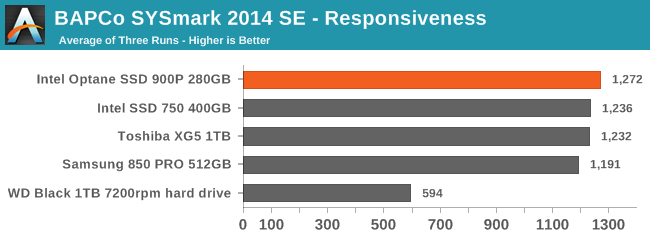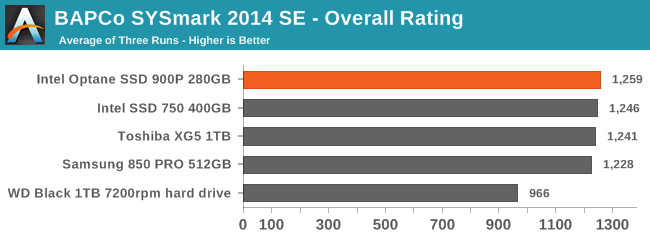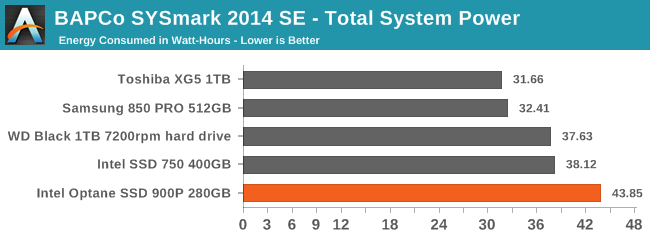The Intel Optane SSD 900P 280GB Review
by Billy Tallis on October 27, 2017 9:30 AM ESTBAPCo SYSmark 2014 SE
BAPCo's SYSmark 2014 SE is an application-based benchmark that uses real-world applications to replay usage patterns of business users in the areas of office productivity, media creation and data/financial analysis. In addition, it also addresses the responsiveness aspect which deals with user experience as related to application and file launches, multi-tasking etc. Scores are calibrated against a reference system that is defined to score 1000 in each of the scenarios. A score of, say, 2000, would imply that the system under test is twice as fast as the reference system.
SYSmark scores are based on total application response time as seen by the user, including not only storage latency but time spent by the processor. This means there's a limit to how much a storage improvement could possibly increase scores, because the SSD is only in use for a small fraction of the total test duration. This is a significant difference from our ATSB tests where only the storage portion of the workload is replicated and disk idle times are cut short to a maximum of 25ms.
| AnandTech SYSmark SSD Testbed | |
| CPU | Intel Core i5-7400 |
| Motherboard | ASUS B250-PLUS |
| Chipset | Intel B250 |
| Memory | 2x 8GB Kingston DDR4-2400 CL17 |
| Case | In Win C583 |
| Power Supply | Cooler Master G550M |
| OS | Windows 10 64-bit, version 1703 |
Our SSD testing with SYSmark uses a different test system than the rest of our SSD tests. This machine is set up to measure total system power consumption rather than just the drive's power.


SYSmark 2014 SE doesn't come close to stressing the storage system enough to show meaningful distinctions between high-end NVMe SSDs. The Responsiveness sub-test is the most sensitive to storage performance, and only shows a few percent difference between most SSDs. The overall test barely registers a difference at all. But with my primary power meter broken, SYSmark does provide a rough assessment of how power hungry the Intel Optane SSD 900P is:

The SYSmark energy usage scores measure total system power consumption, excluding the display. Our SYSmark test system idles at around 26 W and peaks at over 60 W measured at the wall during the benchmark run. SATA SSDs seldom exceed 5 W and idle at a fraction of a watt, and the SSDs spend most of the test idle.
Despite being the fastest drive in this bunch and thus the one with the shortest SYSmark run times, the Optane SSD 900P used far more energy over the course of the three SYSmark runs. With higher idle power than even the Intel SSD 750 and similar power draw under load, the Optane SSD 900P really needs its heatsink. Intel is a very long way off from being able to package this level of performance in a M.2 SSD.










205 Comments
View All Comments
Lolimaster - Saturday, October 28, 2017 - link
The past is the past, few years ago, a 20GB HDD cost $200 so?btb - Saturday, October 28, 2017 - link
Does the Optane 900P have support for hardware based Bitlocker encryption?Currently I have a motherboard with a TPM, and an SSD with Microsoft eDrive/TCG Opal/IEEE 1667 support, and thus support for hardware based(not software) Bitlocker.
Would the Optane work in a similar manner, if I use it as a boot drive?
voicequal - Saturday, October 28, 2017 - link
Mixed reads & writes are a significant weak spot for SSD performance, where a sequential write workload can degrade a sequential read workload and vice versa. It looks like Optane has completely resolved this (no more bathtub curve). It would be interesting to see a mixed sequential test with QD > 1, so that both read & write requests are in the queue. In theory, throughput could be 2x under 50/50 mixed workloads if Optane is fast enough to saturate the full duplex paths, like the PCIe bus, in both directions.evilpaul666 - Saturday, October 28, 2017 - link
I ordered a 480GB AIC version from the popular online vendor. I was surprised it was actually available. Seems to be bucking a trend this year.Hopefully, Intel ironed out the bugs and there won't be crashes until multiple firmware updates over the next year.
Anecdotally, I've heard good things about improved UX. I'll find out in a few days. It's replacing an Intel 750 400GB from about two years ago.
Mikewind Dale - Saturday, October 28, 2017 - link
This is awesome. But what excites me most is using XPoint to replace RAM.I wonder, can we get an approximate simulation of what that world could be like, by making a system with a deliberately minuscule amount of RAM, installing a 32 GB Optane module, and setting the Windows page file to be on that Optane module? I'd be interested to see some benchmarks.
evilpaul666 - Saturday, October 28, 2017 - link
There was a demo of a system with only 4GB RAM that was supposed to have had good results."Bullwinkle J Moose" - Saturday, October 28, 2017 - link
Would System Start-up be any faster?---------------------------------------------------
Faster that what? Apples to Bannana's?
A 35 Watt Dualcore Sandy bridge will boot a fresh install of Windows 10 Fall Crapper Edition (Sept 2017) in 5.35 seconds to a Samsung 850 Pro
or, the same computer will boot a fresh install of Windows XP-SP2 in 3 - 4 seconds (it varies every boot)
Then, I've seen people bragging on youtube for booting new 90+ Watt Quadcore machines to Windows 10 on an M.2 drive in 17 seconds
So, wutz your opinion?
How fast is fast ?
cheshirster - Sunday, October 29, 2017 - link
Those prices are FAKE.CaedenV - Sunday, October 29, 2017 - link
Come on Intel! Storage isn't what this tech is made for! This was supposed to have faster throughput and act as a RAM replacement, not SSD replacement! Being able to replace RAM and storage with something that is slightly slower than RAM, but the capacity of a large SSD would have huge benefits. Imagine 'launching' a program and all that needs to be done is to flip a flag from inactive to active and your whole program is up and running. No loading from the HDD/SSD into RAM, just activate a section of memory and update the windows registry keys if needed. Having direct HDD/SSD access to the CPU without needing to load into RAM first. These would be huge advantages. But instead Intel saw that it wasnt going to be good enough for that so they released what they had as a way to cash in and make up for all of the wasted R&D on this tech over the years.Granted; it is not ALL bad. For consumers this would be like burning money. But for business use this is amazing tech. At my work we have a huge document management system with some ~6 million documents in it, and 200+ users running searches on them all the time. On HDD these searches would take just over a minute. We recently moved the search cache to SSDs which dropped the search time down to ~10-20 sec. With Optane we could lower it to near instant search times. Not going to do it any time soon, but there is absolutely a market for this kind of tech in the business IT world. I just don't understand why Intel is marketing it to gamers.
Reflex - Sunday, October 29, 2017 - link
To be fair, the software ecosystem is a decade or more behind the concept of unified memory. Even if this was a capable RAM replacement today, nothing could take advantage of it, and wouldn't be able to for a very long time.